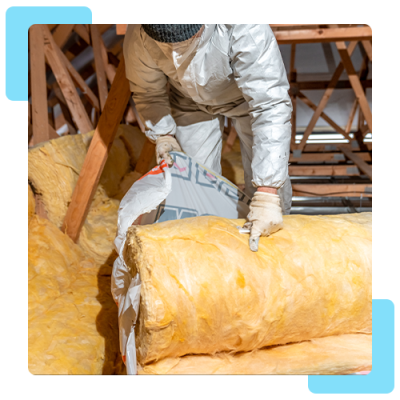Insulation Removal

Unlock Your Home's Energy Efficiency with Insulation Replacement
A healthy and energy-efficient home starts with insulation removal
You need to remove old insulation to maintain a healthy and energy-efficient home. Insulation deteriorates over time and loses its ability to keep indoors warm. Moisture, pests, and settling make it worse. To solve these issues and keep your home comfortable all year round, you need to remove insulation.
Aging insulation and the need to remove it
When insulation ages, you need to remove it to restore energy efficiency. Insulation that’s old doesn’t retain heat or cool air well. It is exacerbated by pests, moisture, and settling.
Why it is necessary to remove insulation
In the event that your insulation is damaged, you will experience:
Poor insulation makes heating and cooling systems work harder.
Due to uneven temperatures and drafts, it may be difficult to remain comfortable.
The benefits of removing home insulation
Insulation that is outdated, damaged, or inadequate may cause the following problems:
In addition to being more effective, modern insulation is also more environmentally friendly.
You can reduce energy waste and save money by replacing old insulation.
Pest-infested insulation is a problem
Rodents, insects, and birds often construct nests and burrows in insulation. Contamination, unpleasant odors, and health risks are present. As a result of the removal of insulation, pests are eradicated and safety and cleanliness are restored.
Pest infestations and insulation
When insulation is infested, waste, bacteria, and allergens can affect indoor air quality.
It is decaying materials and pest droppings that cause the odors in your home.
It is possible for pest-contaminated insulation to cause respiratory issues or other illnesses, particularly if you suffer from allergies or asthma.
Eliminate insulation to prevent water damage and mold
In addition to affecting indoor air quality, moldy or water-damaged insulation can cause serious health problems. In order to remove mold, prevent water intrusion, and prevent further damage, it is necessary to remove insulation.
Moldy insulation should be discarded as soon as possible
Mold spores can cause respiratory issues, allergies, and other illnesses.
Mold-contaminated insulation spreads allergens and toxins throughout your home.
Energy efficiency can be achieved by removing insulation
In order to improve energy efficiency, you might need to remove insulation:
For remodeling projects, insulation needs to be adjusted.
You can upgrade to code-compliant insulation by removing the old insulation.
A healthy and efficient environment can be achieved by removing home insulation
Insulation must be removed in order to create a healthy and energy-efficient home. Your house remains comfortable regardless of the weather outside.
The benefits of removing insulation
The following can be accomplished by removing old, damaged, or inadequate insulation:
It should be comfortable inside.
Eliminate dust, mold, and allergens from outdated insulation.
By keeping your home well insulated, you will spend less on heating and cooling.
Removing insulation for long-term sustainability
Your house will be more comfortable and eco-friendly if you install insulation. Reduce your carbon footprint, conserve resources, and save energy.
Step-by-step guide to removing insulation
Preparation and assessment
Our first step is to assess the existing insulation to determine what type, condition, and extent of removal is necessary. Additionally, we check for potential hazards.
Safety and containment are the next steps
In order to prevent insulation particles, dust, and contaminants from spreading, we seal off the work area. As a result, your home and the workers are protected.
Thirdly, remove the insulation
The insulation is carefully removed using specialized tools. It will not cause too much disruption to your home during this process.
In the fourth step, cleaning and decontamination are performed
Our next step is to thoroughly clean the work area, removing all debris, dust, and residue. As soon as that has been completed, the space is ready for further work.
The fifth step is to get rid of it
The insulation is bagged or contained and disposed of properly. Disposal that is environmentally friendly and compliant.
Post-removal inspection
A post-removal inspection is conducted to ensure that all insulation has been removed. In addition, we ensure that the area is clean and ready for insulation.
What are the benefits of hiring a professional to remove insulation?
Expertise and knowledge
Professionals in the insulation industry are familiar with potential hazards. Health and property risks can be reduced by performing the job in a safe manner.
Insulation removal that is efficient
Experts know how to remove different types of insulation without causing damage to surrounding structures. Expertise reduces the amount of effort and time required.
Safe handling of hazardous materials
Asbestos is handled and disposed of properly by experts. The environment and you are protected.
Convenience and confidence
Hiring professionals ensures that the work is done correctly, minimizes disruptions, and ensures a smooth transition. It reduces stress, saves time, and produces excellent results.
Safety and Health concerns
Pest Infestations control
Renovation and Remodeling
Poor Indoor Air Quality
Energy Efficiency Upgrade
Mold and Moisture Prevention
Mastering the Art of Insulation Removal in 6 Essential Steps
Step 1: Prepare and assess
Firstly, we’ll assess the existing insulation to see what kind, condition, and extent needs to be removed. Any potential hazards will also be inspected in the work area.
Here’s step 2: Safety and containment
The work area will be contained to prevent insulation particles, dust, and contaminants from spreading. It keeps your home and the workers clean and safe.
The third step is to take off the insulation
Specialized tools and equipment will be used to remove the insulation. In this step, you’ll make sure the removal goes smoothly.
Decontamination and cleaning
The work area will be cleaned thoroughly after the insulation is removed. No contamination risks, so the environment will be safe.
Here are five. Waste disposal
Insulation will be bagged or contained according to local regulations and disposed of responsibly. By doing this, we ensure proper waste management and minimal environmental impact.
Here’s the sixth. Inspection post-removal
We’ll do a post-removal inspection to make sure all the insulation is gone. We’ll also make sure the area is clean and ready for insulation or renovations.
Looking to get in touch with us for a free quote?
Do-It-Yourself VS Professional Insulation Removal
Expertise and knowledge
To handle potential hazards associated with the process, professionals have the knowledge, experience, and safety gear. Their expertise ensures the job is done right and safely, reducing property and health risks.
Removal that’s efficient
Moreover, they know how to remove different types of insulation without damaging the surrounding structures. The process saves you time and effort.
Hazardous materials
Asbestos and other hazardous materials can also be removed. This expertise protects you and the environment.
Convenience and confidence
There is minimal disruption, extensive insulation removal, and seamless transitions. Save time, effort, and stress while achieving high-quality results.
Keep Your Attic Moisture Free
Lower Room Temperatures
Extend the Life of Your Roof
Bestway reduce Utility Bills
Looking to get in touch with us for a free quote?
How Insulation Can Help with Home Renovations
Renovations are fun, but they’re also tough. Most homeowners are looking for…
The Importance of Proper Floor Insulation
If you’re trying to save energy in your home or business, you…
Insulating Your Walls: What You Need to Know
You need to insulated your walls if you want your house to…
Contact us

Testimonials
Bestway arrived on time and installers were very thorough and highly skilled/coordinated. Completed install in good time and left everything clean and tidy. Would not hesitate to recommend.
Everything was great until it came to measuring the square footage. They claimed 3,000 sq. Ft. I had blueprints and recognized they were charging for significantly larger area than the plans said. Over measure by roughly 450 sq. Ft. They argued I agreed to pay on 3000. I argued I agreed to pay on sq. Footage. If you use these people, they do a great job, make sure you measure the area yourself. As their math does not add up all the time.
These guys post fake pictures specially on facebook of jobs that belong to other companies, i informed the owner multiple times and yet he has like 10 different fake account posting my jobs all over facebook, this guy doesn’t care about the law or whatsoever, everything about this company is cheap and trust me whatever you will see in real life from them will be far far from what u see in the pictures.
Amazing service and very professional business. I had reached out to Ali for a quote (very reasonable pricing) and was there the next day to get the job done. Their team is punctual and very organized. Overall great experience and will definitely use this company for all other future projects!
Ali and his team were exceptional — they went the extra mile to get the job done..
What stood out most was their sincerity and honesty. They didn’t try to upsell unnecessary services and gave straightforward recommendations tailored to my home’s needs. Their efficiency was impressive—the work was completed quickly without sacrificing quality, and my home is already noticeably more comfortable.
Friendly hard working cleaned up after themselves
recently had insulation in my home, and I can’t recommend them highly enough! From start to finish, their professionalism and expertise shone through. Their attention to detail was impeccable—every corner and crevice was perfectly insulated,l The materials they used were top-notch, and the installation was completed efficiently without any mess. If you’re looking for insulation done right, this is the company to call!
I hired bestway for attic insulation and they did a great job. The team was friendly, efficient, and explained everything clearly. Their prices were fair and I’ve already noticed a difference in my home. Highly recommend their services!
Very happy with Bestway Insulation. Their staff is very friendly and professional. Would highly recommend.
Ali and his team are great. He went above and beyond to fit me in, even though it was last minute. They were efficient and on time. Cleaned up and left everything as I expected. Will call them again for any insulation project.
Awesome experience! Alibhai and crew worked very efficiently and we passed the insulation inspection for entire house (5200 sqft) in one goal! The inspectors were so happy to see his quality of work! I'll Definitely recommend him for any insulation needs! Thanks again!
Bestway came to top off my insulation in my attic. They were in time and finished in a timely manner. They cleaned up when they were done and everything looked fantastic.










